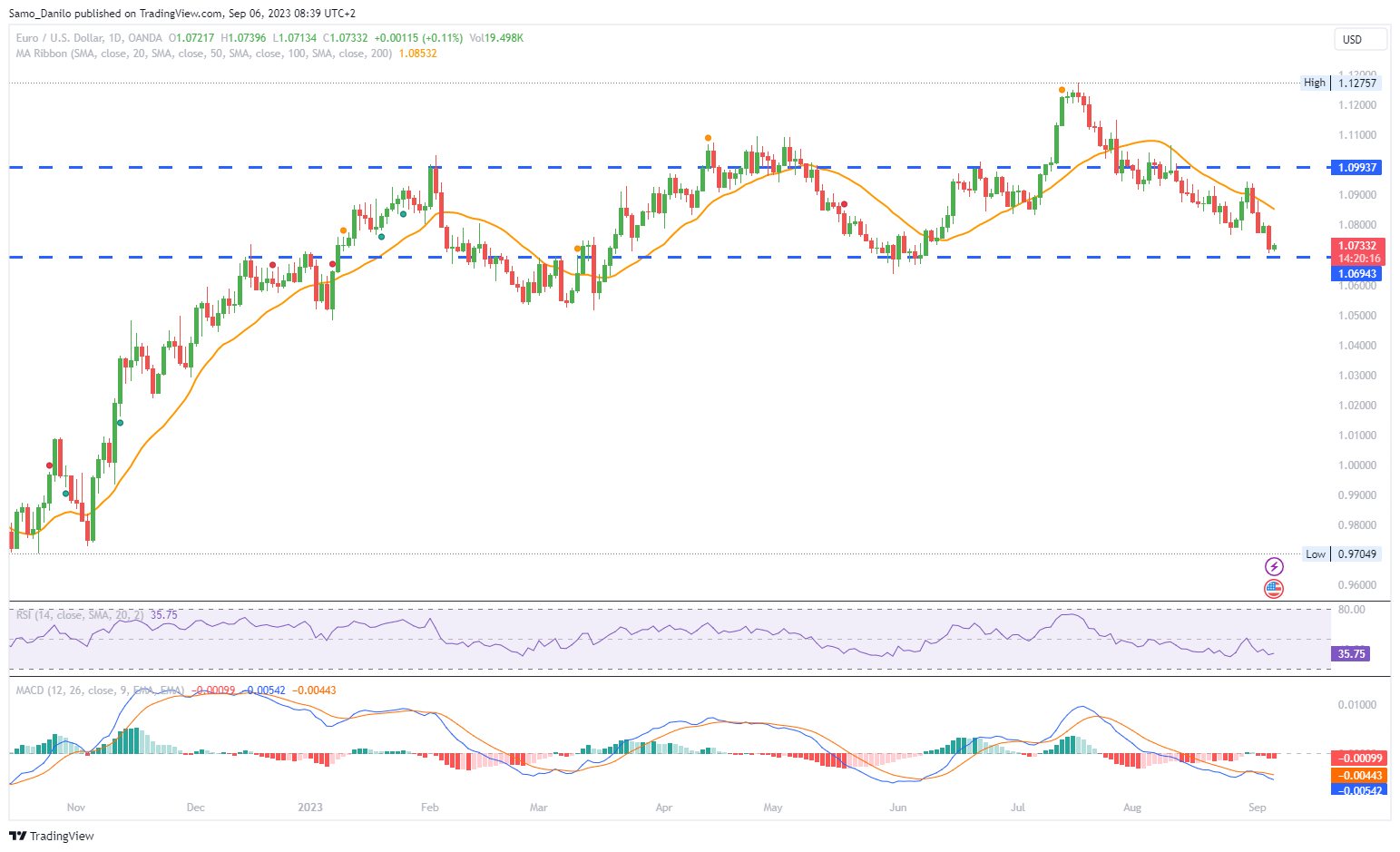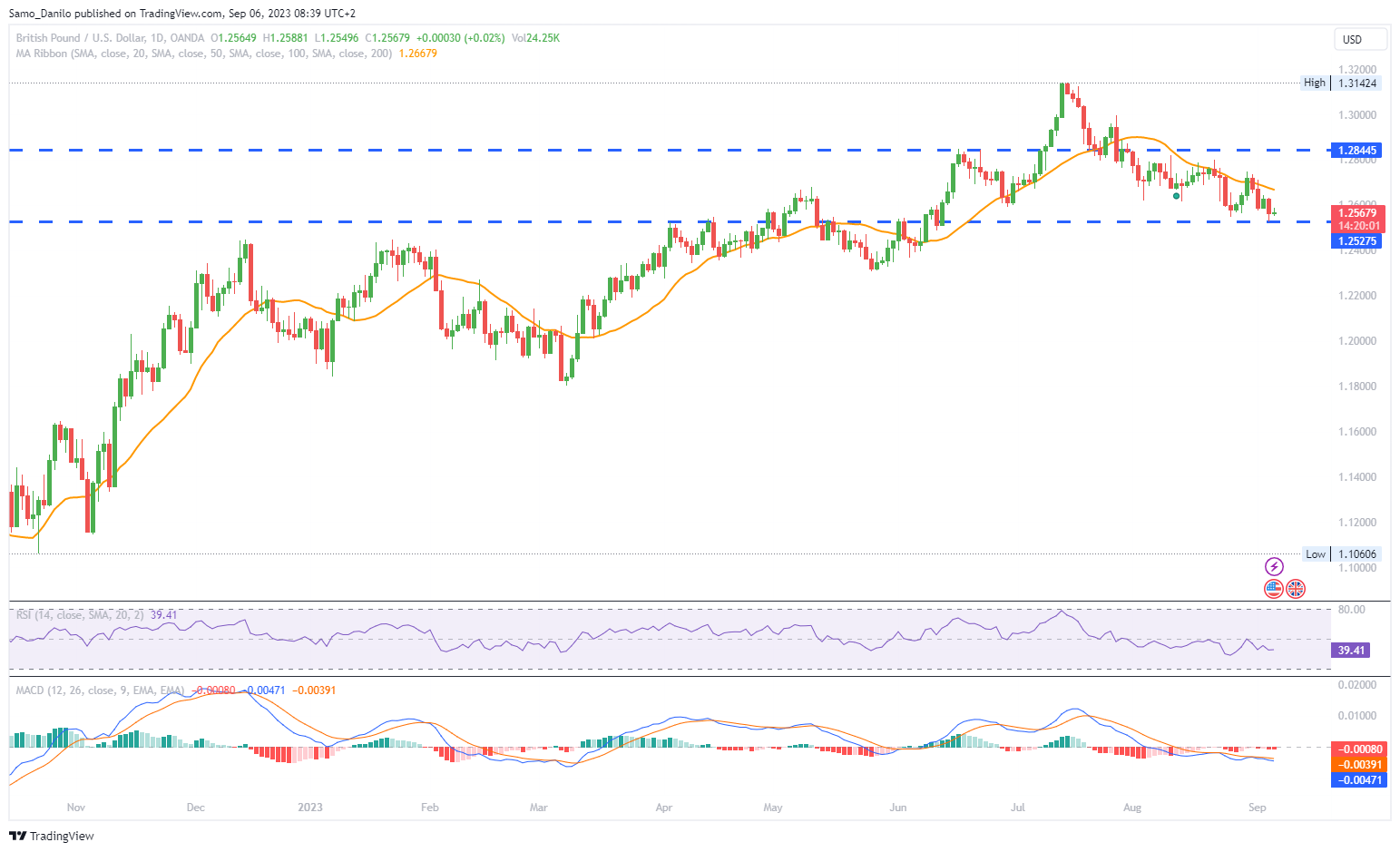EURUSD
- The EUR/USD currency pair is currently experiencing selling pressure, with the exchange rate hovering near 1.0732 during the early Asian trading session on Wednesday.
- The Euro (EUR) has weakened against the US Dollar (USD) due to growing concerns about a potential recession in the Eurozone. These concerns stem from recent weaker economic data from the region.
- The Euro's performance has been negatively impacted by downward revisions to key economic indicators. In particular, the September Purchasing Managers' Index (PMI) for the Eurozone's services sector came in at 47.9, falling below the preliminary reading of 48.3. This suggests a contraction in the services sector, adding to economic worries.
- Recent economic data from the United States has indicated strength, which is affecting the EUR/USD pair. This data suggests that Federal Reserve officials may keep the possibility of further interest rate hikes open.
- Market participants are keenly awaiting economic data releases. Germany is scheduled to release Factory Orders data, while the Eurozone will provide Retail Sales figures. In the United States, the ISM Services PMI report is also expected.
Closing statement: The EUR/USD pair is facing selling pressure due to concerns about a potential Eurozone recession and weaker economic data. The market will closely monitor upcoming data releases for further insights into the economic health of both the Eurozone and the United States, which could influence the direction of this currency pair.
GBPUSD
- GBP/USD has come under renewed bearish pressure, reaching its lowest level since June 13, falling below 1.2530 during the European morning on Tuesday.
- Mixed economic data from the UK has failed to provide support to the Pound Sterling. While the British Retail Consortium reported a 4.1% annual increase in retail sales for August, exceeding the three-month average of 3.6%, there are also negative indicators.
- Barclays reported that annual growth in consumer spending on credit and debit cards slowed to 2.8% in August, down from 4.0% in July. This slowdown suggests potential weaknesses in consumer activity.
- The UK S&P Global/CIPS Composite Purchasing Managers' Index (PMI) declined to 48.6 in August from 50.8 in July. This marks the lowest reading since January. The drop was mainly driven by a decrease in the Services PMI, which fell to 49.5, below the 50-point threshold that separates expansion from contraction.
- Despite the mixed economic data indicating that additional rate hikes by the Bank of England (BoE) may not be warranted, money market futures are still pricing in a 25-basis point rate hike, as reflected in interest rate probabilities.
| SMA (20) | Falling |
|
|
| RSI (14) | Slightly Falling |
| |
| MACD (12, 26, 9) | Neutral |
Closing statement: GBP/USD is facing renewed bearish pressure due to mixed economic data from the UK. While retail sales exceeded expectations, other factors, such as slowing consumer spending and declining PMI figures, are contributing to a cautious outlook for the British Pound. Interest rate expectations by market participants remain a key factor to watch in this currency pair.
GOLD
- Gold prices have reached fresh six-day lows, hovering around $1,925, following a four-day losing streak. This decline comes as the United States Dollar (USD) rally takes a pause.
- The recent strength in the US Dollar can be attributed to risk-aversion in the markets, fueled by resurfacing concerns about global economic growth. The US Dollar Index climbed to around 105.00, marking its highest level in nine months.
- Federal Reserve Governor Christopher Waller mentioned on Tuesday that further rate hikes would depend on data, emphasizing the need for more information before concluding that the Fed has finished raising rates. Such comments can influence market expectations regarding future interest rate decisions.
- The focus in the market is now turning towards high-impact economic data from the US. The release of the top-tier US ISM Services PMI data during the North American session on Wednesday, as well as the final S&P Services PMI and the Goods Trade Balance data, will be closely watched by gold traders.
| SMA (20) | Neutral | ||
| RSI (14) | Neutral | ||
| MACD (12, 26, 9) | Neutral |
Closing statement: Gold prices have experienced a recent decline as the US Dollar rally temporarily takes a break. However, the overall direction of gold will likely be influenced by upcoming economic data, especially the US ISM Services PMI, and how these numbers impact expectations regarding future Federal Reserve rate hikes. Risk sentiment in the market will also play a crucial role in gold's movement.
CRUDE OIL
- Crude oil prices experienced a slight decline in early Asian trading on Wednesday, following a previous session where they rose by over 1%. This comes as concerns about a supply shortage emerge after Saudi Arabia and Russia decided to extend their voluntary supply cuts until the end of the year.
- While investors had anticipated that Saudi Arabia and Russia would extend voluntary cuts into October, the announcement of a three-month extension was unexpected. These cuts are in addition to the April cut agreed upon by several OPEC+ producers, which is set to continue until the end of 2024.
- The consequences of these extended cuts on inflation and economic policy in Western countries are uncertain. However, higher oil prices could increase the likelihood of fiscal tightening measures, particularly in the U.S., to counteract inflationary pressures.
- Saudi Arabia and Russia plan to review their cut decisions on a monthly basis. Depending on market conditions, they may consider deepening the cuts or increasing output.
- It's worth noting that the annual refinery maintenance period in the U.S. from September to October could limit the demand for crude oil, potentially acting as a factor restraining rising oil prices.
| SMA (20) | Slightly Rising |
| |
| RSI (14) | Slightly Falling |
|
|
| MACD (12, 26, 9) | Rising |
|
|
Closing statement: Crude oil prices are experiencing fluctuations, with concerns about supply shortages due to extended voluntary cuts by Saudi Arabia and Russia. The impact of these cuts on inflation and economic policies in Western countries remains uncertain, and ongoing reviews of the cut decisions will be closely monitored. Additionally, the upcoming U.S. refinery maintenance period could influence crude oil demand and prices.
DAX
- The DAX index continued its descent, marking a three-day losing streak with a 0.34% fall on Tuesday.
- Eurozone service sector PMIs for August added to recessionary fears. Unexpected contractions were observed across the Italian and Spanish service sectors, which weighed on investor sentiment. Additionally, poor service sector PMI numbers for France, Germany, and the Eurozone as a whole contributed to the bearish mood.
- Commerzbank was the worst performer on the DAX on Tuesday, tumbling by 6.10%. This decline was driven by news of Barclays downgrading the stock to underweight. Concerns over non-performing loans have been weighing on Commerzbank.
- Later in the session, Eurozone retail sales numbers are expected to provide direction. Economists forecast a 0.1% decline in retail sales across the Eurozone. A continued downward trend in consumer spending would add to concerns about a Eurozone recession, as household spending accounts for approximately 50% of the euro area economy.
- ECB Executive Board Member Elizabeth McCaul is scheduled to speak. Given that the markets are still betting on a September ECB rate hike, any comments suggesting a shift in monetary policy could provide support.
| SMA (20) | Neutral |
| RSI (14) | Neutral |
| MACD (12, 26, 9) | Neutral |
Closing statement: The DAX's decline has been driven by recessionary fears in the Eurozone, with poor service sector PMI numbers and concerns about non-performing loans at Commerzbank contributing to the negative sentiment. Retail sales data and ECB communications are closely monitored for further insights into the economic and monetary policy outlook.





